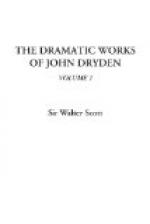Dryden attached considerable importance to the art with which the comic and tragic scenes of the “Spanish Friar” are combined; and in doing so he has received the sanction of Dr. Johnson. Indeed, as the ardour of his mind ever led him to prize that task most highly, on which he had most lately employed his energy, he has affirmed, in the dedication to the “Spanish Friar,” that there was an absolute necessity for combining two actions in tragedy, for the sake of variety. “The truth is,” he adds, “the audience are grown weary of continued melancholy scenes; and I dare venture to prophesy, that few tragedies, except those in verse, shall succeed in this age, if they are not lightened with a course of mirth; for the feast is too dull and solemn without the fiddles.” The necessity of the relief alluded to may be admitted, without allowing that we must substitute either the misplaced charms of versification, or a secondary comic plot, to relieve the solemn weight and monotony of tragedy. It is no doubt true, that a highly-buskined tragedy, in which all the personages maintain the funereal pomp usually required from the victims of Melpomene, is apt to be intolerably tiresome, after all the pains which a skilful and elegant poet can bestow upon finishing it. But it is chiefly tiresome, because it is unnatural; and, in respect of propriety, ought no more to be relieved by the introduction of a set of comic scenes, independent of those of a mournful complexion, than the sombre air of a funeral should be enlivened by a concert of fiddles. There appear to be two legitimate modes of interweaving tragedy with something like comedy. The first and most easy, which has often been resorted to, is to make the lower or less marked characters of the drama, like the porter in “Macbeth,” or the fool in “King Lear,” speak the language appropriated to their station, even in the midst of the distresses of the piece; nay, they may




